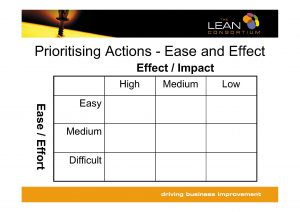If you’re swamped with improvement ideas and suggestions, here’s a quick team-based approach to prioritising them – Ease and Effect:
- Write each idea on a sticky note
- In turn, read out / explain to the team each improvement idea
- For each idea, first ask the team “How Easy do we think it would be to implement this idea?” Get the team to reach consensus on this – “Easy”, “Medium” or “Difficult”
- Secondly, ask the team “If we did it, how much impact or Effect would this idea have?” Get the team to reach consensus on this – “High”, “Medium” or “Low”
- Use a flipchart sheet or large piece of paper and draw out a 3 x 3 Ease and Effect Grid. Use the vertical for “Ease” and split this into the three categories “Easy”, Medium” and Difficult. Use the horizontal for “Effect” and split this into the three categories “High”, “Medium” and “Low”.
- After each idea has been reviewed and ranked, place the sticky note in one of the nine boxes, based on its “Ease” and “Effect” rating.
- Prioritise the ideas based on the following ranking:
- Easy to do, with High Effect
- Easy to do, with Medium Effect
- Medium to do, with High Effect
Keep track of progress using a simple traffic light (RAG) system – ideas that you haven’t yet started are coloured Red, ideas that you’re currently working on are coloured Amber and ideas that have been completed are colured Green.
You can download a copy of the Ease and Effect Grid (and lots of other useful stuff) here: http://www.nicholsonconsultancy.com/free-downloads/
And if you’d like some help in running your own Ease and Effect sessions, contact Andrew.Nicholson@ImproveMyFactory.com


